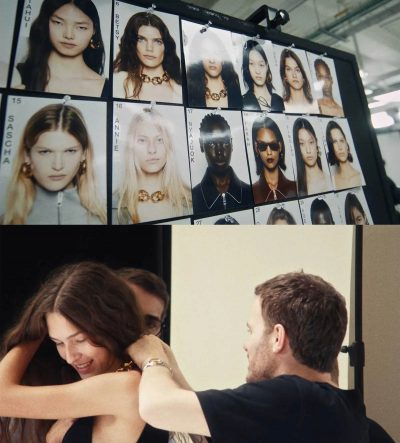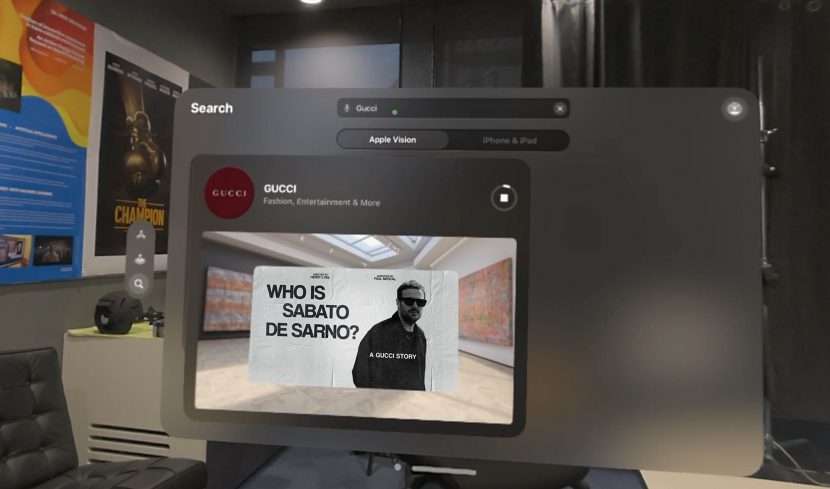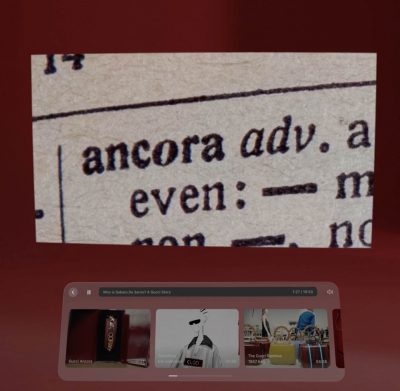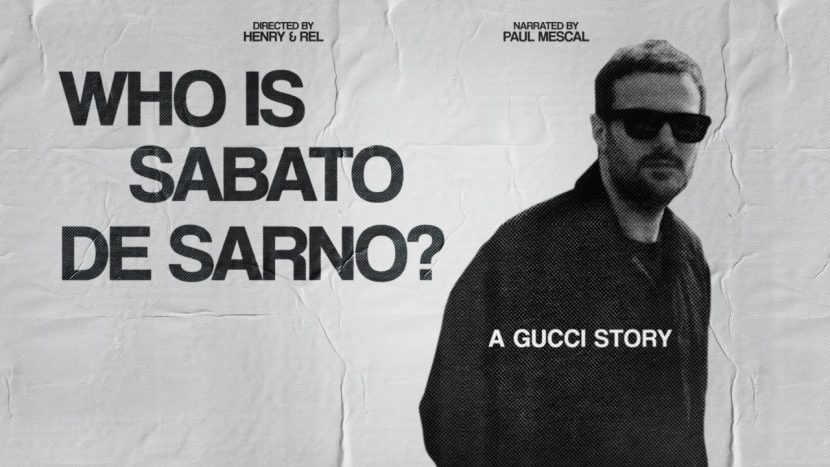Yesterday, Gucci released an immersive, mixed-reality version of its new documentary on creative director Sabato De Sarno for the Apple Vision Pro (AVP). The documentary is directed by Ariel Schulman and Henry Joost and documents the creation of the first Gucci ‘Ancora’ fashion show by the fashion house’s new Creative Director, Sabato De Sarno. The story takes viewers through the weeks leading up to de Sarno’s debut show in September 2023 which was called Gucci Ancora. “Ancora is a word that you use when your desire is not over yet, whether it’s a kiss, an embrace, or making love,” explains Sabato De Sarno. “It’s as if you own something and you want more of it. I wanted to fall in love with fashion all over again – ancora.”
This App/documentary is a significant move as it is one of the first examples of providing a new experience in narrative documentary using spatial computing. Unlike other earlier VR headsets and similar devices, the Apple Vision Pro provides an extremely high-quality viewing experience. But beyond the ability to watch conventional 2D or 3D movies in crystal clear clarity, the film highlights the ability to provide an enhanced experience with both novelty and interactivity.

The film becomes dramatically more interesting not just by viewing 3D versions of Gucci’s shoes and handbags, but by providing various engaging new cinematic tricks and immersive elements. Take, for instance, a scene where Sabato De Sarno discusses his beloved dog. Here, viewers are treated to the whimsical sight of a small 3D dog ambling leisurely across the screen’s foreground. Similarly, when the focus shifts to the runway, the film cleverly extends the runway’s base into the viewer’s space, surrounding them with the spectacle. Despite the potential for these elements to distract, they instead add a layer of fun and whimsy to the experience.
It’s essential to highlight that, despite the innovative features mentioned, the true magic of this film, like many offerings on the Apple Vision Pro, is something that must be experienced firsthand to be fully appreciated. While descriptions can capture the imagination, they often fall short of conveying the full impact. This is a recurring theme with the Apple Vision Pro; we’ve enthusiastically shared stories about its various engaging applications with countless individuals. Yet, it is only through personal experience that one can truly grasp the value, leading to many moments of revelation accompanied by exclamations of “Oh, now I get it,” particularly after interactive experiences like ‘patting a dinosaur’.
The Apple Vision Pro is designed to be an experiential device rather than merely a display device, pushing the boundaries of traditional film viewing. Furthermore, the filmmakers have embraced spatial computing to integrate the storyline and its elements seamlessly into the viewer’s physical space. This approach not only fully engages the viewer’s field of view at times but also gently invites further engagement for those curious to explore more deeply. The result is a truly experiential journey that transcends the conventional viewing experience, demonstrating the filmmakers’ commitment to not just showing a film in 3D but creating an immersive world that viewers can interact with and inhabit, making the film a great experience.

However, simply projecting a desktop environment into the Apple Vision Pro’s virtual space may not fully leverage the platform’s innovative potential. While the AVP’s ability to display a virtual laptop screen hovering in mid-air is impressive, it’s crucial to recognize that this does not inherently solve a problem or enhance functionality beyond the capabilities of a high-quality Apple monitor. In other words, “a monitor works fine – why do I need to put on an AVP?!?” This approach reflects a common trajectory in the adoption of new technologies, where initial applications often seek to extend the familiar functionalities of older systems into new forms.
Historically, every major technological advancement has undergone a period of transitional use, where its applications merely mimic the capabilities of its predecessors. This phenomenon is evident in how radio plays were initially adapted to television broadcasts, personal computers were seen as portable versions of desktops, iPhones were marketed as superior phones, and tablets as portable e-books. Even the internet, in its nascent stages, was often viewed as a digital space for static brochures rather than a dynamic medium for new content. This conservative approach fails to anticipate the transformative impact these technologies would have when used to their full potential.
The real breakthroughs came when innovators moved beyond seeing these platforms as mere enhancements of existing tools. For instance, Facebook, YouTube, and TikTok succeeded not by digitizing traditional content but by creating new ‘platforms’ for content creation and sharing, – giving rise to billion-dollar companies. Similarly, Microsoft even invested in electronic encyclopedias and WebTV back in the day, but it was Wikipedia and YouTube that truly capitalized on the internet’s potential by facilitating unprecedented levels of user engagement and content democratization.
It quickly becomes clear that the greatest promise of the Apple Vision Pro lies not in just replicating the functions of a conventional monitor but in exploring entirely new dimensions of interaction and immersion. To fully realize the AVP’s potential, we must envision applications that go beyond the limitations of existing technologies, imagining new ways for users to interact with digital content that are as innovative and transformative as the platforms that have reshaped our digital landscape in the past. This perspective challenges us to rethink our approach to emerging technologies, recognizing that the most interesting impacts often arise from uses that were initially unimaginable to those tethered to the paradigms of the past.
Evaluating the Apple Vision Pro since it launched has led us to believe that it is the new ways of doing things that is interesting not just repackaging the old and offering it up via a different medium. Our assessment here at fxguide reveals a unanimous interest in the fresh avenues the Apple Vision Pro opens up. Our expertise doesn’t typically extend to the avant-garde world of fashion, yet the Gucci documentary, ‘Who is Sabato De Sarno? A Gucci Story,’ captivated our attention. It wasn’t just the story itself but how it was told—leveraging the unique capabilities of the AVP to introduce visual surprises that not only captivated viewers but also emphasized the narrative’s key themes.
While it may not clinch an Oscar for Best Documentary, this film stands as a testament to the untapped potential of a new media platform to change storytelling. The AVP, in this instance, serves as more than just a new backdrop; it is an integral part of the storytelling process, allowing creators to weave narrative and visual elements in ways that were previously unimaginable. As creatives continue to experiment with and understand the full scope of what platforms like the AVP can offer, we anticipate a surge in compelling effects that stretches the boundaries of traditional media formats.
A good friend once pointed out that if you are sent an amazing timelapse video on Youtube, you start watching, you are stunned by how they could have spent years timelapse recording a tree growing or a city changing, but after 30 seconds – if you are honest – you fast forward. We do this knowing full well that the timelapse video is a masterpiece of patience and technology… but without an engaging narrative – new tech can just be cool… but unlike to be something you leaning into. This tendency underscores a fundamental truth about human engagement with media—without a compelling narrative, even the most technologically advanced or visually stunning content just doesn’t hold our attention. Of course, this also underlines that this documentary only works because the core documentary is interesting and well-told. You need both a good story and an interesting presentation of that story.
When watching the Gucci documentary, – is just really interesting and fun to watch. It sort of solves the ‘dual screen’, half watching a show, – tiktok short attention span viewing problem.
In a LinkedIn Gucci article, the company’s VP of brand innovation ventures, Micael Barilaro commented that “While recent applications of the Apple Vision Pro have predominantly revolved around e-commerce, we recognised the importance of charting a distinct course that resonated with our brand ethos. Our focus lies in crafting curated, emotionally resonant experiences that place emphasis on meaningful engagement,” He states that their new film experience is designed to take audiences on a captivating journey and amplify the messaging of the whole Gucci Ancora first collection. And it does seem to underline and extend many of the fashion house’s visual metaphors and stories through new visual engagement.
What will be amazing is to see other filmmakers build on this and explore further completely new approaches to interesting stories and experiences beyond just re-packing existing approaches.



